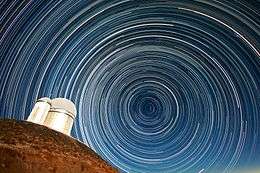Circumpolar constellation
In astronomy, a circumpolar constellation is a constellation (group of stars) that never sets below the horizon, as viewed from a location on Earth.[1] Due to Earth's rotation and axial tilt with respect to the Sun, the stars and constellations can be divided into two categories. Those stars and constellations that never rise or set are called circumpolar. The rest are divided into seasonal stars and constellations.

The stars and constellations that are circumpolar depends on the observer's latitude. In the Northern Hemisphere, certain stars and constellations will always be visible in the northern circumpolar sky.[2] The same holds true in the Southern Hemisphere, where certain stars and constellations will always be visible in the southern circumpolar sky. The celestial north pole, currently marked by Polaris less than 1° away, always has an azimuth equal to zero. The pole's altitude for a given latitude Ø is fixed, and its value is given by the following formula: A = 90° - Ø. All stars with a declination less than A are not circumpolar.[3]
As viewed from the North Pole, all fully visible constellations north of the celestial equator are circumpolar, and likewise for constellations south of the celestial equator as viewed from the South Pole. As viewed from the Equator, no circumpolar constellations are visible. As viewed from mid-northern latitudes (40–50° N), circumpolar constellations may include Ursa Major, Ursa Minor, Draco, Cepheus, Cassiopeia, and the less-known Camelopardalis.[4]
References
- Shivers, Jay S. (2011), Programming Recreational Services, Jones & Bartlett Publishers, p. 319, ISBN 1449656250.
- Ridpath, Ian (2006), Eyewitness Companions: Astronomy, Penguin, p. 148, ISBN 0756648459.
- Karttunen, Hannu; Kröger, Pekka; Oja, Heikki; Poutanen, Markku; Donner, Karl Johan, eds. (2007), Fundamental Astronomy (5th ed.), Springer Science & Business Media, p. 19, ISBN 3540341447.
- Young, Charles Augustus (1897), Uranography: A Brief Description of the Constellations Visible in the United States, with Star-maps, and Lists of Objects Observable with a Small Telescope, Ginn, pp. 9–14.